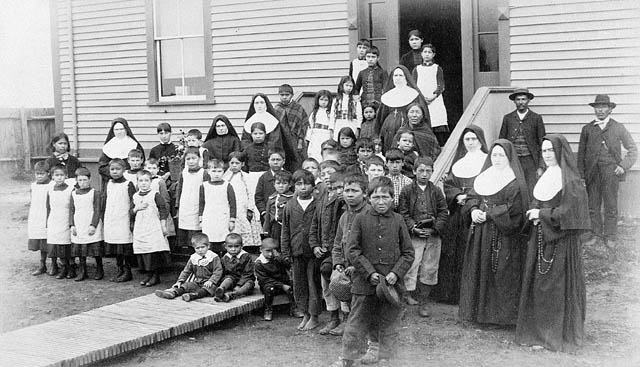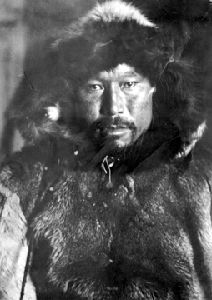Browse "Indigenous Peoples"
-
Article
Chanie Wenjack
Chanie “Charlie” Wenjack (born 19 January 1954; died 23 October 1966 near Redditt, ON). Chanie Wenjack, an Anishinaabe boy from Ontario, ran away from his residential school near Kenora at age 12, and subsequently died from hunger and exposure to the harsh weather. His death in 1966 sparked national attention and the first inquest into the treatment of Indigenous children in Canadian residential schools.
"https://d2ttikhf7xbzbs.cloudfront.net/media/media/d977d73d-e6e6-4d17-8807-e4eae8c74305.JPG" // resources/views/front/categories/view.blade.php
https://d2ttikhf7xbzbs.cloudfront.net/media/media/d977d73d-e6e6-4d17-8807-e4eae8c74305.JPG -
Article
Kyuquot and Checleseht First Nations
The Kyuquot (Ka:’yu:’k’t’h’) and Checleseht (Chek’tles7et’h’) First Nations make up the northernmost Nuu-chah-nulth communities on the west coast of Vancouver Island, British Columbia. Once separate bands, the Kyuquot and Checleseht officially amalgamated in 1962. Both are currently self-governing nations under the Maa-nulth Treaty.
"https://d2ttikhf7xbzbs.cloudfront.net/media/media/7341256a-7b45-4fcd-b945-4b606038ef74.JPG" // resources/views/front/categories/view.blade.php
https://d2ttikhf7xbzbs.cloudfront.net/media/media/7341256a-7b45-4fcd-b945-4b606038ef74.JPG -
Article
Chief
Chief is a word used to denote status or leadership upon an individual in a group, clan or family. The origin of the word is European; colonists used it to refer to the leaders of Indigenous nations during the era of contact. While different Indigenous nations have their own terms for chief, the English version of the word is still used widely to describe leaders tasked with promoting cultural and political autonomy. The term is also used by institutions and organizations that are not exclusively Indigenous to refer to heads of staff (e.g., chief of police, commander-in-chief, chief executive officer). This article explores the historical and contemporary uses of the term in the Indigenous context.
"https://d2ttikhf7xbzbs.cloudfront.net/media/media/523486d8-e1c9-46a3-bfce-7ffa41907512.jpg" // resources/views/front/categories/view.blade.php
https://d2ttikhf7xbzbs.cloudfront.net/media/media/523486d8-e1c9-46a3-bfce-7ffa41907512.jpg
-
Article
Tsilhqot'in (Chilcotin)
The Tsilhqot'in (Chilcotin) are an Indigenous people who live between the Fraser River and the Coast Mountains in west-central British Columbia. Traditionally Dene (Athabascan) speaking, their name means "people of the red river" and also refers to the Chilcotin Plateau region in British Columbia. The Tsilhqot’in National Government is a tribal council established in 1989 that represents the six member First Nations of the Chilcotin Plateau. In 2014, the Tsilhqot’in people won a Supreme Court of Canada case that focused on the issue of Aboriginal title. In 2018, Prime Minister Justin Trudeau formally apologized to the Tsilhqot’in people for the wrongful conviction and hanging of Tsilhqot’in chiefs during the Chilcotin War of 1864.
"https://d2ttikhf7xbzbs.cloudfront.net/media/media/1209caa7-baef-416b-85cf-5a9975513dd9.jpg" // resources/views/front/categories/view.blade.php
https://d2ttikhf7xbzbs.cloudfront.net/media/media/1209caa7-baef-416b-85cf-5a9975513dd9.jpg
-
List
Children’s Books About Residential Schools in Canada
Church-run schools for Indigenous children were created in Canada in the 1600s. In 1883, the Canadian government funded and helped establish more church-run schools. The goal was to assimilate Indigenous children into the dominant white, Christian society. By the time the last residential school closed in 1996, more than 150,000 First Nation, Métis and Inuit children had been forced to attend against their will and the wishes of their parents. Many children were physically, emotionally and sexually abused at the schools. Thousands died. The multigenerational social and psychological effects of the schools have been devastating and ongoing. The federal government and churches have apologized for what is now widely considered a form of genocide. (See also Genocide and Indigenous Peoples in Canada.) Knowledge of what happened at the schools is an essential part of reconciliation and healing. Many children’s books have been written about residential schools as part of that essential effort. This list includes titles for toddlers to preteens. Together, these books explore a variety of themes related to residential schools, including intergenerational trauma, language revitalization, commemoration and the power of resistance.
"https://d2ttikhf7xbzbs.cloudfront.net/media/media/86457bd9-5e52-4288-a765-42d9611c9554.jpg" // resources/views/front/categories/view.blade.php
https://d2ttikhf7xbzbs.cloudfront.net/media/media/86457bd9-5e52-4288-a765-42d9611c9554.jpg
-
Article
Denesuline (Chipewyan)
The Denesuline (also known as Chipewyan) are Indigenous Peoples in the Subarctic region of Canada, with communities in Manitoba, Saskatchewan, Alberta and the Northwest Territories. The Denesuline are Dene, and share many cultural and linguistic similarities with neighbouring Dene communities. The 2021 census reported that 4,815 people claimed to be of Denesuline ancestry. However, the registered population of Denesuline First Nations may be higher. Denesuline are closely associated with other Dene groups as well as northern Cree and Métis, who may share their communities and also speak Denesuline. As such, population and language numbers are approximations.
"https://d2ttikhf7xbzbs.cloudfront.net/media/media/d042a7cd-8095-4a4a-b112-ef4791bf04c6.jpg" // resources/views/front/categories/view.blade.php
https://d2ttikhf7xbzbs.cloudfront.net/media/media/d042a7cd-8095-4a4a-b112-ef4791bf04c6.jpg
-
Article
Cindy Blackstock
Cindy Blackstock, OC, social worker, author, professor, advocate (born 1964 in Burns Lake, BC). Blackstock is a nationally and internationally respected advocate for the rights of Indigenous children. She co-founded the First Nations Child and Family Caring Society in 1998. Later, Blackstock led the organization’s case against the federal government from 2007–16. The Caring Society argued child welfare services provided to First Nations children and families on-reserve were discriminatory and flawed. Blackstock and the Caring Society continue to work toward improving child and family services for Indigenous children across Canada.
"https://d2ttikhf7xbzbs.cloudfront.net/CindyBlackstock/cindyblackstock1.jpg" // resources/views/front/categories/view.blade.php
https://d2ttikhf7xbzbs.cloudfront.net/CindyBlackstock/cindyblackstock1.jpg
-
Article
Tla-o-qui-aht (Clayoquot)
The Tla-o-qui-aht First Nation (meaning the “people from Clayoqua” or the people from “Tla-o-qui”) are a member of the Nuu-chah-nulth Tribal Council. Tla-o-qui-aht territory is located on the west coast of Vancouver Island, British Columbia. As of September 2018, the nation has a registered population of 1,147 registered members.
"https://d2ttikhf7xbzbs.cloudfront.net/media/media/4e0c3130-e80d-4e28-991d-0e077b5deb77.jpg" // resources/views/front/categories/view.blade.php
https://d2ttikhf7xbzbs.cloudfront.net/media/media/4e0c3130-e80d-4e28-991d-0e077b5deb77.jpg
-
Article
Coast Salish
Coast Salish peoples have historically occupied territories along the Northwest Pacific Coast in Canada and the United States. Though each nation is different, Coast Salish peoples generally have strong kinship ties and engage in political, treaty and environmental partnerships.
"https://d2ttikhf7xbzbs.cloudfront.net/media/media/b2896e4c-6595-4766-806c-936eb1f7ba34.jpg" // resources/views/front/categories/view.blade.php
https://d2ttikhf7xbzbs.cloudfront.net/media/media/b2896e4c-6595-4766-806c-936eb1f7ba34.jpg
-
Article
Columbia River Treaty
The Columbia River Treaty was signed by Canada and the US on 17 Jan 1961 after 15 years of preliminary investigation by the International Joint Commission, and one year (1960) of direct international negotiation. It dealt with the co-operative development of the Columbia River.
"https://development.thecanadianencyclopedia.ca/images/tce_placeholder.jpg?v=e9dca980c9bdb3aa11e832e7ea94f5d9" // resources/views/front/categories/view.blade.php
https://development.thecanadianencyclopedia.ca/images/tce_placeholder.jpg?v=e9dca980c9bdb3aa11e832e7ea94f5d9
-
Article
Congress of Aboriginal Peoples
The Congress of Aboriginal Peoples (CAP) speaks primarily for Indigenous peoples living off reserve in Canada. In 1993, under the leadership of Jim Sinclair, CAP grew out of a reorganization of the Native Council of Canada (NCC). Since its founding in 1971, the central objective of the NCC, and now CAP, has been to represent the interests of off reserve Status and Non-Status people, Métis and Southern Inuit.
"https://d2ttikhf7xbzbs.cloudfront.net/media/media/35d9c4df-d960-4667-a478-d7eb82199581.jpg" // resources/views/front/categories/view.blade.php
https://d2ttikhf7xbzbs.cloudfront.net/media/media/35d9c4df-d960-4667-a478-d7eb82199581.jpg
-
Article
Contemporary Indigenous Art in Canada
Contemporary Indigenous art is that which has been produced by Indigenous peoples between around 1945 to the present. Since that time, two major schools of Indigenous art have dominated the contemporary scene in Canada: Northwest Coast Indigenous Art and the Woodland school of Legend Painters. As well, a more widely scattered group of artists work independently in the context of mainstream Western art and may be described as internationalist in scope and intent. Contemporary Inuit art has evolved in parallel with contemporary Indigenous art, producing celebrated artists like Zacharias Kunuk and Annie Pootoogook. (See also Important Indigenous Artists in Canada and History of Indigenous Art in Canada.)
"https://d2ttikhf7xbzbs.cloudfront.net/media/media/8a90dd14-410f-43b4-a0d6-c7b47c511e95.jpg" // resources/views/front/categories/view.blade.php
https://d2ttikhf7xbzbs.cloudfront.net/media/media/8a90dd14-410f-43b4-a0d6-c7b47c511e95.jpg
-
Article
Inuinnait (Copper Inuit)
Social organization was based on kinship and on various types of formal partnership, and affiliation between individuals tended to be more a matter of personal choice than is usually found among other Inuit groups.
"https://d2ttikhf7xbzbs.cloudfront.net/media/media/904d87cb-9998-4625-b627-84ca8857abcc.jpg" // resources/views/front/categories/view.blade.php
https://d2ttikhf7xbzbs.cloudfront.net/media/media/904d87cb-9998-4625-b627-84ca8857abcc.jpg
-
Article
Inuit Country Food in Canada
Country food is a term that describes traditional Inuit food, including game meats, migratory birds, fish and foraged foods. In addition to providing nourishment, country food is an integral part of Inuit identity and culture, and contributes to self-sustainable communities. Environmental and socioeconomic changes have threatened food security, making country food more expensive and difficult to harvest. Despite these challenges, the Inuit, in partnership with various levels of government and non-profit organizations, continue to work towards improving access to country food.
"https://d2ttikhf7xbzbs.cloudfront.net/media/media/6d6d0dcf-4f29-4d58-817d-3e2cad84c4b7.jpg" // resources/views/front/categories/view.blade.php
https://d2ttikhf7xbzbs.cloudfront.net/media/media/6d6d0dcf-4f29-4d58-817d-3e2cad84c4b7.jpg
-
Article
Cowichan Sweater
The Cowichan sweater is a garment created in North America with a distinctly patterned design knitted out of bulky-weighted yarn. It originated during the late 19th century among the Cowichan, a Coast Salish people in British Columbia. Historically also called the Indian sweater or Siwash sweater (a derogatory Chinook word for Indigenous people), the Cowichan people reclaimed the name after the 1950s as a means of emphasizing their claim to the garment. The popularity of the sweater by the mid-1900s thrust Cowichan sweaters into the world of international fashion, where they have been appropriated by non-Indigenous designers. Nevertheless, several knitters from various Coast Salish communities around Vancouver Island and the mainland of British Columbia continue to create and sell authentic sweaters. In 2011, the Canadian government recognized Cowichan knitters and sweaters as nationally and historically significant.
"https://d2ttikhf7xbzbs.cloudfront.net/media/new_article_images/cowichansweater/1024px-Cowichan_Sweater2.jpg" // resources/views/front/categories/view.blade.php
https://d2ttikhf7xbzbs.cloudfront.net/media/new_article_images/cowichansweater/1024px-Cowichan_Sweater2.jpg


